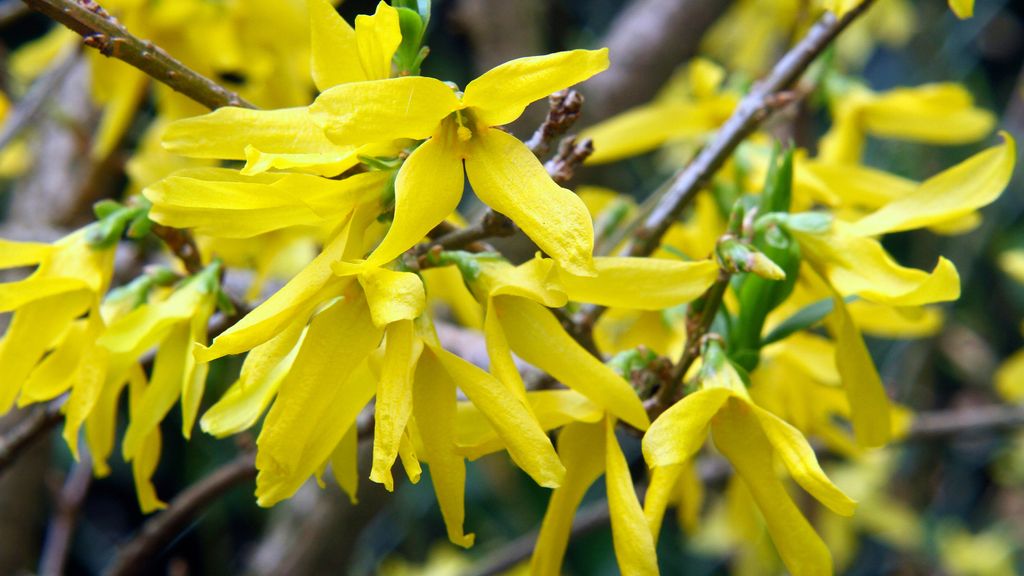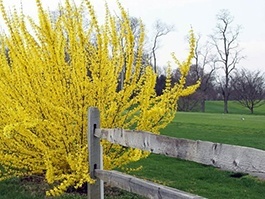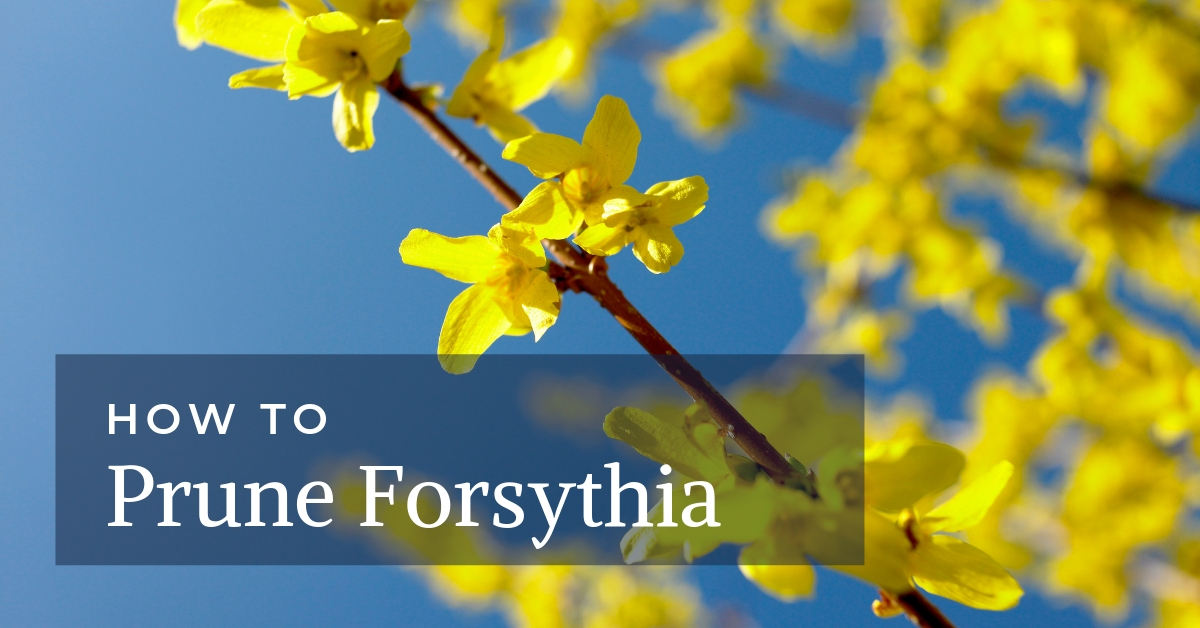Understanding the Best Time to Prune Your Forsythia
Pruning forsythia bushes is an essential part of maintaining their health, promoting blooming, and achieving the desired shape. However, timing is crucial when it comes to pruning these beautiful flowering shrubs. Pruning at the right time can make all the difference in encouraging healthy growth, maximizing blooms, and preventing potential problems.
So, when to trim forsythia bushes? The ideal time to prune forsythia bushes is immediately after they finish blooming in the spring. This allows you to enjoy the blooms while also giving the plant enough time to produce new growth and set buds for next year’s flowers. Pruning too early or too late can reduce blooming, weaken the plant, and make it more susceptible to disease and pests.
Pruning in the spring also helps to remove any dead, diseased, or damaged branches that may have been damaged over the winter. This helps to prevent the spread of disease and encourages healthy growth. Additionally, spring pruning allows you to shape the plant and maintain its desired size and shape.
It’s also important to note that forsythia bushes typically bloom on old wood, meaning that the flowers are produced on stems that grew the previous year. Therefore, pruning too much of the old wood can reduce blooming. However, pruning some of the old wood can help to encourage new growth and promote more blooms.
By pruning your forsythia bushes at the right time, you can enjoy beautiful blooms, maintain a healthy plant, and achieve the desired shape. Remember to prune immediately after blooming in the spring, and avoid pruning too much of the old wood to ensure maximum blooms.
How to Prune Forsythia for Maximum Blooms
Pruning forsythia bushes requires a thoughtful and deliberate approach to maximize blooms and maintain the desired shape. Here’s a step-by-step guide on how to prune forsythia bushes:
Step 1: Gather the Right Tools
Before starting the pruning process, make sure to gather the right tools, including loppers, pruners, and gloves. High-quality tools will make the pruning process easier and more efficient.
Step 2: Remove Dead or Damaged Branches
Begin by removing any dead or damaged branches from the forsythia bush. Cut these branches off at the base, making a clean cut just above a growth node. This will help prevent the spread of disease and encourage healthy growth.
Step 3: Cut Back Stems
Next, cut back the stems of the forsythia bush to the desired length. Cut just above a growth node, making a clean cut at a 45-degree angle. This will help the plant grow new stems and promote blooming.
Step 4: Shape the Plant
Use the pruners to shape the plant, removing any branches that are growing outside of the desired shape. Make clean cuts, and avoid tearing the bark or damaging the plant.
Step 5: Thin Out the Center
Finally, thin out the center of the forsythia bush, removing any branches that are growing towards the center of the plant. This will help allow air and light to reach the center of the plant, promoting healthy growth and blooming.
By following these steps, you can prune your forsythia bushes to maximize blooms and maintain the desired shape. Remember to prune immediately after blooming in the spring, and avoid pruning too much of the old wood to ensure maximum blooms.
The Consequences of Pruning at the Wrong Time
Pruning forsythia bushes at the wrong time can have serious consequences for the plant’s health and blooming potential. If you prune your forsythia bushes too early or too late, you may inadvertently reduce blooming, weaken plant growth, and increase the risk of disease or pests.
One of the most significant consequences of pruning at the wrong time is reduced blooming. Forsythia bushes typically bloom on old wood, meaning that the flowers are produced on stems that grew the previous year. If you prune too much of the old wood, you may inadvertently remove the buds that would have produced flowers, resulting in reduced blooming.
Pruning at the wrong time can also weaken plant growth. Forsythia bushes need time to recover from pruning, and pruning at the wrong time can disrupt this process. If you prune too early or too late, you may inadvertently stress the plant, making it more susceptible to disease or pests.
In addition to reduced blooming and weakened plant growth, pruning at the wrong time can also increase the risk of disease or pests. Forsythia bushes are susceptible to diseases such as powdery mildew and pests such as aphids and spider mites. Pruning at the wrong time can create wounds that provide an entry point for these diseases and pests, making the plant more vulnerable to infection.
So, when to trim forsythia bushes? The ideal time to prune forsythia bushes is immediately after they finish blooming in the spring. This allows you to enjoy the blooms while also giving the plant enough time to produce new growth and set buds for next year’s flowers. By pruning at the right time, you can avoid the consequences of pruning at the wrong time and promote healthy growth, blooming, and overall plant health.
Identifying the Right Tools for the Job
When it comes to pruning forsythia bushes, having the right tools for the job is essential. Using high-quality pruning tools can make the pruning process easier and more efficient, while also helping to prevent damage to the plant.
One of the most important tools for pruning forsythia bushes is a good pair of loppers. Loppers are long-handled pruning shears that are designed for cutting thicker branches. Look for loppers with sharp blades and comfortable grips to make the pruning process easier.
In addition to loppers, a good pair of pruners is also essential for pruning forsythia bushes. Pruners are handheld pruning shears that are designed for cutting smaller branches and stems. Look for pruners with sharp blades and comfortable grips to make the pruning process easier.
Gloves are also an important tool for pruning forsythia bushes. Pruning can be a messy and thorny process, and gloves can help protect your hands from thorns and sap. Look for gloves that are durable and comfortable to wear.
Other tools that may be useful for pruning forsythia bushes include a pruning saw and a hedge trimmer. A pruning saw can be used to cut thicker branches, while a hedge trimmer can be used to shape and maintain the overall shape of the plant.
When selecting pruning tools, look for high-quality tools that are designed specifically for pruning forsythia bushes. Avoid using low-quality tools that can damage the plant or make the pruning process more difficult.
Some popular brands for pruning tools include Fiskars, Corona, and Felco. These brands offer a range of high-quality pruning tools that are designed for pruning forsythia bushes and other plants.
By using the right pruning tools, you can make the pruning process easier and more efficient, while also helping to promote healthy growth and blooming in your forsythia bushes. Remember to prune your forsythia bushes immediately after they finish blooming in the spring, and avoid pruning too much of the old wood to ensure maximum blooms.
Pruning for Different Shapes and Sizes
One of the benefits of pruning forsythia bushes is the ability to shape and maintain the desired shape and size. Whether you want to maintain a compact shape, promote a more natural growth habit, or create a topiary, pruning can help you achieve your goals.
To maintain a compact shape, prune your forsythia bushes regularly to remove any dead or damaged branches. Cut back the stems to the desired length, and shape the plant to maintain a neat and tidy appearance.
To promote a more natural growth habit, prune your forsythia bushes less frequently, allowing the plant to grow and develop its natural shape. Remove any dead or damaged branches, and shape the plant to maintain a balanced and harmonious appearance.
To create a topiary, prune your forsythia bushes regularly to maintain a specific shape or design. Use a combination of pruning and training to shape the plant into the desired form, and remove any dead or damaged branches to maintain a healthy and thriving plant.
When pruning forsythia bushes for different shapes and sizes, it’s essential to consider the plant’s natural growth habit and prune accordingly. Prune in the spring, immediately after blooming, to avoid removing the buds that would have produced flowers.
Some popular shapes and sizes for forsythia bushes include:
- Compact shape: 2-3 feet tall and wide
- Natural growth habit: 3-5 feet tall and wide
- Topiary: 5-7 feet tall and wide
By pruning your forsythia bushes regularly and considering the plant’s natural growth habit, you can achieve the desired shape and size and enjoy beautiful blooms and a healthy, thriving plant.
Common Mistakes to Avoid When Pruning Forsythia
When pruning forsythia bushes, it’s essential to avoid common mistakes that can damage the plant or reduce its blooming potential. Here are some common mistakes to avoid:
Over-pruning: Pruning too much of the plant can stress it and reduce blooming. Only prune what is necessary to maintain the desired shape and size.
Under-pruning: Failing to prune enough can lead to a leggy or overgrown plant. Regular pruning is necessary to maintain a healthy and balanced plant.
Pruning at the wrong time: Pruning at the wrong time can reduce blooming or damage the plant. Prune forsythia bushes immediately after they finish blooming in the spring.
Not removing dead or damaged branches: Failing to remove dead or damaged branches can lead to disease or pest problems. Regularly inspect the plant and remove any dead or damaged branches.
Not using the right pruning tools: Using the wrong pruning tools can damage the plant or make the pruning process more difficult. Use high-quality pruning tools, such as loppers and pruners, to make the pruning process easier and more efficient.
Not pruning for the right reasons: Pruning forsythia bushes should be done to maintain the desired shape and size, promote healthy growth, and encourage blooming. Avoid pruning for the wrong reasons, such as to simply cut back the plant.
By avoiding these common mistakes, you can prune your forsythia bushes effectively and maintain a healthy, thriving plant with beautiful blooms.
Pruning Forsythia in Different Climates and Regions
Pruning forsythia bushes in different climates and regions requires some adjustments to accommodate varying weather conditions. Here are some tips on how to prune forsythia bushes in different climates and regions:
In warmer climates, such as in Southern California or Florida, forsythia bushes may require more frequent pruning to maintain their shape and size. Prune in the late winter or early spring, before new growth begins.
In cooler climates, such as in the Northeast or Midwest, forsythia bushes may require less frequent pruning. Prune in the late spring or early summer, after the plant has finished blooming.
In areas with high winds or extreme weather conditions, forsythia bushes may require more frequent pruning to maintain their shape and size. Prune in the late winter or early spring, before new growth begins.
In areas with poor soil quality, forsythia bushes may require more frequent pruning to promote healthy growth. Prune in the late winter or early spring, before new growth begins.
When pruning forsythia bushes in different climates and regions, it’s essential to consider the plant’s specific needs and adjust your pruning schedule accordingly. Prune at the right time, and use the right pruning tools to make the pruning process easier and more efficient.
Some popular pruning schedules for forsythia bushes in different climates and regions include:
- Warm climates: Prune every 2-3 months during the growing season.
- Cool climates: Prune every 6-12 months during the dormant season.
- High-wind areas: Prune every 2-3 months during the growing season.
- Poor soil quality: Prune every 2-3 months during the growing season.
By adjusting your pruning schedule to accommodate the specific needs of your forsythia bushes, you can promote healthy growth, encourage blooming, and maintain the desired shape and size.
Maintenance and Care After Pruning
After pruning your forsythia bushes, it’s essential to provide proper maintenance and care to ensure they continue to thrive. Here are some tips on how to care for your forsythia bushes after pruning:
Watering: Water your forsythia bushes regularly, especially during the first year after pruning. Make sure the soil is moist but not waterlogged, as this can lead to root rot and other problems.
Fertilizing: Fertilize your forsythia bushes in the early growing season, using a balanced fertilizer that promotes healthy growth and blooming. Avoid over-fertilizing, as this can damage the plant.
Monitoring for Pests and Diseases: Regularly inspect your forsythia bushes for signs of pests or diseases, such as aphids, whiteflies, or powdery mildew. Take action promptly if you notice any problems, using organic or chemical controls as needed.
Mulching: Mulch around the base of your forsythia bushes to retain moisture, suppress weeds, and regulate soil temperature. Use a thin layer of organic mulch, such as wood chips or bark, and keep it a few inches away from the plant’s stems.
Pruning Maintenance: Regular pruning is essential to maintain the shape and size of your forsythia bushes. Prune your forsythia bushes annually, removing any dead or damaged branches and shaping the plant to maintain its desired shape.
By following these tips, you can provide proper maintenance and care for your forsythia bushes after pruning, ensuring they continue to thrive and produce beautiful blooms.






